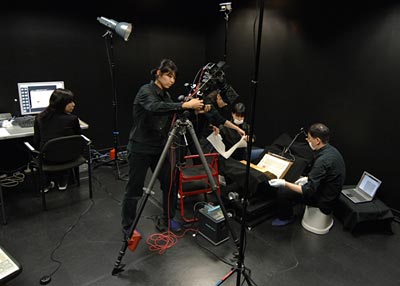 Reproductions of the Gutenberg Bible have proved to be very useful for the analysis of press variants, illumination, and other copy-specific features. Collectors can no longer hope to own a copy of the original, but they can obtain excellent facsimiles, some of which have become highly desirable collectors' items in their own right. The first of the printed facsimiles appeared in 1913 with a commentary volume published in 1923. In some ways it has never been surpassed in printing quality and in the scholarly achievements of the commentary which contains a census of copies and an authoritative account of how the book went through the press. Some of the later facsimiles are less reliable, but they make it possible to compare copies in several European libraries. More affordable and accessible, digital versions of two copies are available on CD-ROM, both containing commentary and offering viewing options such as magnification of images and adjustments of contrast and brightness.
Reproductions of the Gutenberg Bible have proved to be very useful for the analysis of press variants, illumination, and other copy-specific features. Collectors can no longer hope to own a copy of the original, but they can obtain excellent facsimiles, some of which have become highly desirable collectors' items in their own right. The first of the printed facsimiles appeared in 1913 with a commentary volume published in 1923. In some ways it has never been surpassed in printing quality and in the scholarly achievements of the commentary which contains a census of copies and an authoritative account of how the book went through the press. Some of the later facsimiles are less reliable, but they make it possible to compare copies in several European libraries. More affordable and accessible, digital versions of two copies are available on CD-ROM, both containing commentary and offering viewing options such as magnification of images and adjustments of contrast and brightness.
Perhaps it is appropriate that the Internet has become a preferred venue for visual communication even in the precincts of Gutenberg scholarship. Digital reproductions of thirteen copies can be found on the Web, some websites offering special features such as sophisticated navigational tools, close-ups of illumination, a means of downloading high-quality images, and the ability to compare two copies side by side on the same screen. Several of these Web sites provide contextual information about Gutenberg and his invention.
For the prevalence of Gutenberg on the Web, students and scholars are greatly indebted to the work of Keio University's Humanities Media Interface Project (HUMI), established in 1996 when the university acquired its copy of the Gutenberg Bible. Beginning with the Keio copy, the HUMI team has made digital reproductions of eleven sets of the Bible in nine institutions, nineteen volumes altogether. Eight of the copies digitized by HUMI can now be viewed on the Web. HUMI's director, Professor Toshiyuki Takamiya, and its technical director, Professor Masaaki Kashimura, have organized collaborative digitizing projects with libraries large and small the world over and have adopted the latest advances in digital imaging technology to ensure optimum reproduction quality.
Supervised by Professor Kashimura and chief assistant Mayumi Ikeda, a team of HUMI technicians accomplished the digital photography of the Old Testament copy in the course of two weeks, October 15–31, 2008. For the record, it should be noted that they used a Mamiya RZ67 Professional II camera body with Mamiya-Sekor 140mm and 75 mm lenses, a PhaseOne P45+ digital back, PhaseOne CaptureOne 3.7.7 software for image capture, and PhaseOne CaptureOne 4.7 and 4.8.1 software for digital development. Here is a picture of the HUMI team at work, using a special book cradle designed by the HUMI Project. The members of the team were Masaaki Kashimura, Mayumi Ikeda, Katsura Muramatsu, Ryoko Harikae, Yumi Moroi and Kasumi Fukasawa. After processing the digital files, they supplied the Morgan with 1,067 full-size TIFF images, 433 dpi on page surface; 1,067 JPEG images, 216.5 dpi on page surface; 12 pictures documenting the binding and the general appearance of the volume; 85 close-ups of illumination, etc.; and 57 images in raking light and other special lighting effects. The high-resolution TIFF images are available for consultation upon application to the Department of Printed Books & Bindings.
Plan your visit. 225 Madison Avenue at 36th Street, New York, NY 10016.
Plan your visit. 225 Madison Avenue at 36th Street, New York, NY 10016.
